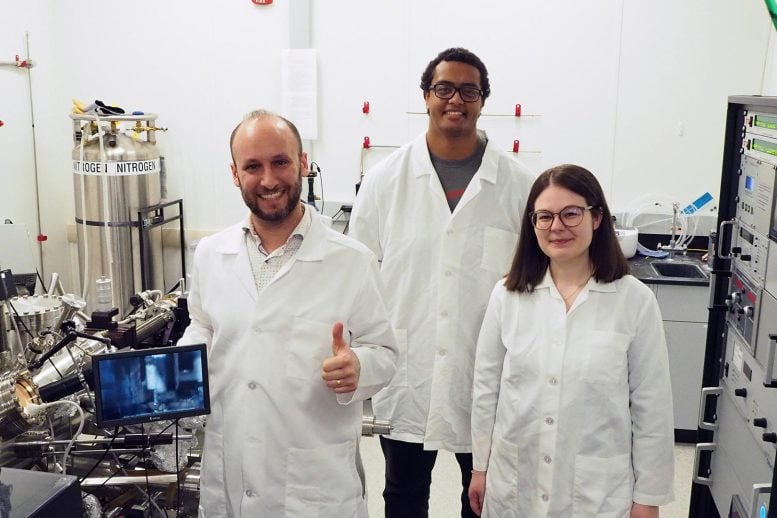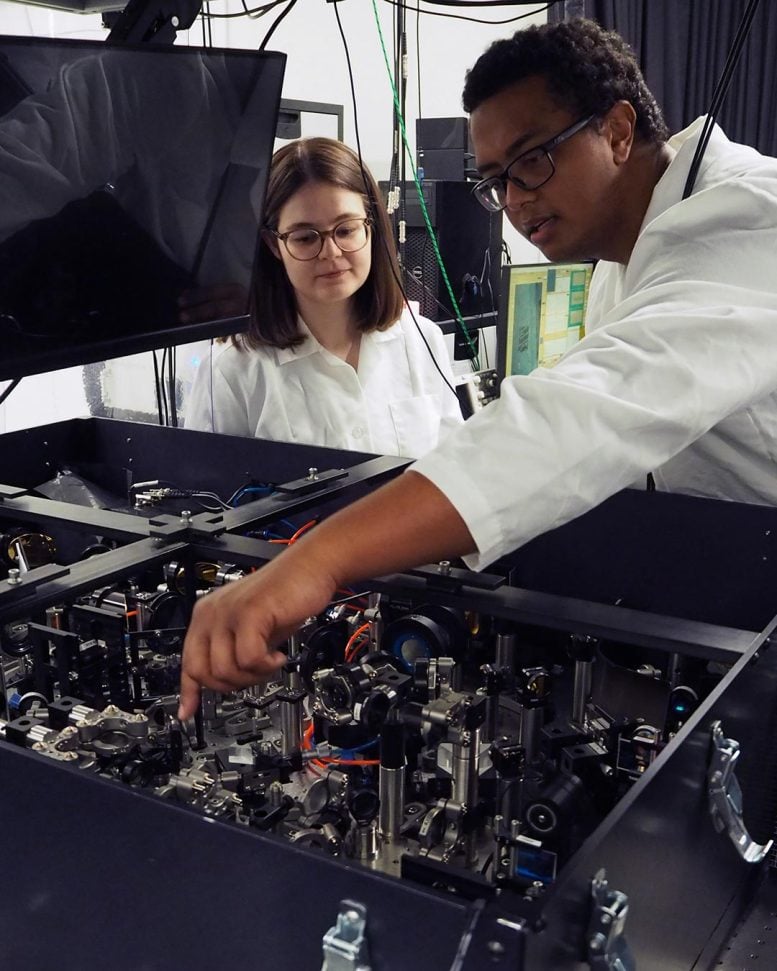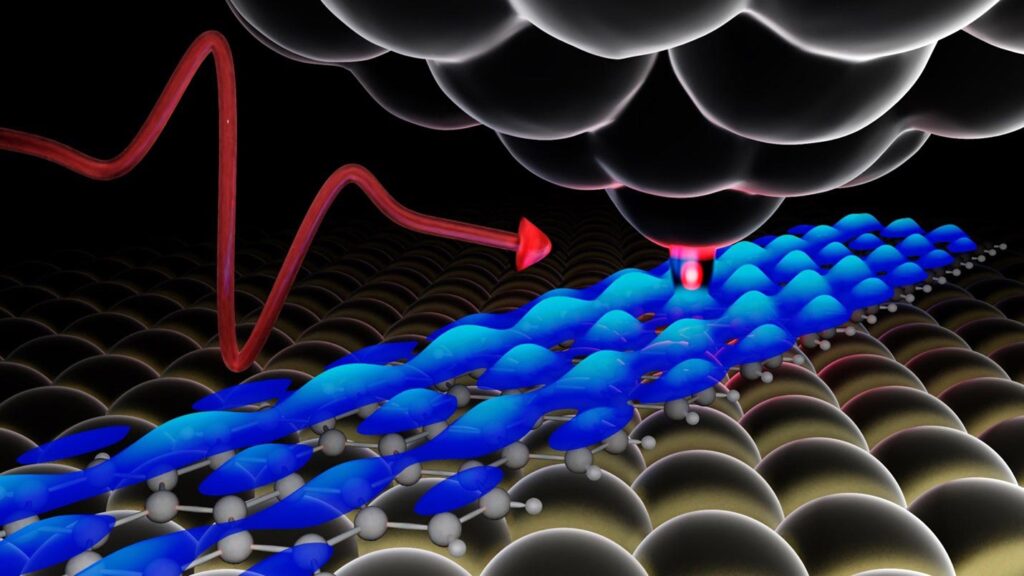Michigan State University combined terahertz laser light, shown as a red wavy arrow, with a scanning tunneling microscope, or STM, tip — the dark pyramid shape exchanging a red electron with a sample shown with a blue surface. Credit: Eve Ammerman
Physicists have developed a groundbreaking technique using high-resolution microscopy and ultrafast lasers to precisely identify defects in semiconductors.
This new method, particularly effective in nanoscale components, enables unprecedented detail in observing electron movement around atomic defects, significantly advancing the field of semiconductor physics and promising new possibilities for materials like graphene.
Advanced Semiconductor Analysis
One of the challenges of cramming smarter and more powerful electronics into ever-shrinking devices is developing the tools and techniques to analyze the materials that make them up with increasingly intimate precision.
Physicists at Michigan State University have taken a long-awaited step on that front with an approach that combines high-resolution microscopy with ultrafast lasers.
The technique, described in the journal Nature Photonics, enables researchers to spot misfit atoms in semiconductors with unparalleled precision. Semiconductor physics labels these atoms as “defects,” which sounds negative, but they’re usually added to materials on purpose and are critically important to the performance of semiconductors in today’s — and tomorrow’s — devices.
“This is particularly relevant for components with nanoscale structures,” said Tyler Cocker, the Jerry Cowen Endowed Chair in Experimental Physics and leader of the new study.

Tyler Cocker (left), the Jerry Cowen Endowed Chair in Experimental Physics at Michigan State University, along with doctoral students Stefanie Adams and Mohamed Hassan in the Ultrafast Terahertz Nanoscopy Laboratory. Credit: Matt Davenport/MSU College of Natural Science
Advancements in Nanoscale Materials
That includes things like computer chips, which routinely make use of semiconductors with nanoscale features. And researchers are working to take nanoscale architecture to an extreme by engineering materials that are a single atom thick.
“These nanoscopic materials are the future of semiconductors,” said Cocker, who also leads the Ultrafast Terahertz Nanoscopy Laboratory in the Department of Physics and Astronomy at MSU. “When you have nanoscale electronics, it’s really important to make sure that electrons can move the way you want them to.”
Defects play a big part in that electron motion, which is why scientists like Cocker are keen to learn precisely where they are located and how they behave. Cocker’s peers have been excited to learn that his team’s new technique will let them easily obtain that information.
“One of my colleagues said, ‘I hope you went out and celebrated,’” Cocker said.
Vedran Jelic, who spearheaded the project as a postdoctoral researcher in Cocker’s group and is now with the National Research Council Canada, is the new report’s first author. The research team also included doctoral students Stefanie Adams, Eve Ammerman and Mohamed Hassan, as well as undergraduate researcher Kaedon Cleland-Host.
Cocker added that the technique is straightforward to implement with the right equipment and his team is already applying it to atomically thin materials like graphene nanoribbons.
“We’ve got a number of open projects where we’re using the technique with more materials and more exotic materials,” Cocker said. “We’re basically folding it into everything we do and using it as a standard technique.”

Doctoral students Mohamed Hassan and Stefanie Adams inspect an optics table to tune the laser light used in the Michigan State University team’s new technique. Credit: Matt Davenport/MSU College of Natural Science
Innovative Microscopy Techniques
There are already tools, notably scanning tunneling microscopes or STMs, that can help scientists spot single-atom defects.
Unlike the microscopes many folks would recognize from high school science classes, STMs don’t use lenses and light bulbs to magnify objects. Rather, STMs scan a sample’s surface using an atomically sharp tip, almost like the stylus on a record player.
But the STM tip doesn’t touch the sample’s surface, it just gets close enough so that electrons can jump, or tunnel, between the tip and the sample.
STMs record how many electrons jump and where they jump from, along with other information, to provide atomic-scale information about samples (thus, why Cocker’s lab refers to this as nanoscopy instead of microscopy).
But STM data alone isn’t always sufficient to clearly resolve defects within a sample, especially in gallium arsenide, an important semiconductor material that’s found in radar systems, high-efficiency solar cells, and modern telecommunication devices.
For their latest publication, Cocker and his team focused on gallium arsenide samples that were intentionally infused with silicon defect atoms to tune how electrons move through the semiconductor.
Discovery and Validation of Defects
“The silicon atom basically looks like a deep pothole to the electrons,” Cocker said.
Although theorists have been studying this type of defect for decades, experimentalists have not been able to detect these single atoms directly, until now.
Cocker and his team’s new technique still uses an STM, but the researchers also shine laser pulses right at the STM’s tip.
These pulses consist of light waves with terahertz frequencies, meaning they jiggle up and down a trillion times per second. Recently, theorists had shown this is the same frequency that silicon atom defects should jiggle back and forth with inside a gallium arsenide sample.
By coupling STM and terahertz light, the MSU team created a probe that has an unparalleled sensitivity for the defects.
When the STM tip came to a silicon defect on the gallium arsenide’s surface, a sudden, intense signal appeared in the team’s measurement data. When the researchers moved the tip an atom away from the defect, the signal disappeared.
“Here was this defect that people have been hunting for over forty years, and we could see it ringing like a bell,” Cocker said.
Theoretical and Practical Achievements
“At first, it was hard to believe because it’s so distinct,” he continued. “We had to measure it in every which way to be certain that this was real.”
Once they were convinced the signal was real, however, it was easy to explain thanks to the years of theory work devoted to the subject.
“When you discover something like this, it’s really helpful when there is already decades of theoretical research thoroughly characterizing it,” said Jelic, who, along with Cocker, is also a corresponding author on the new paper.
Although Cocker’s lab is at the forefront of this field, there are groups around the world currently combining STMs and terahertz light. There are also a variety of other materials that could benefit from this technique for applications beyond detecting defects.
Now that his team has shared its approach with the community, Cocker is excited to see what other discoveries await.
Reference: “Atomic-scale terahertz time-domain spectroscopy” by V. Jelic, S. Adams, M. Hassan, K. Cleland-Host, S. E. Ammerman and T. L. Cocker, 4 July 2024, Nature Photonics.
DOI: 10.1038/s41566-024-01467-2
The project was supported by the Office of Naval Research, the Army Research Office and the Air Force Office of Scientific Research.


